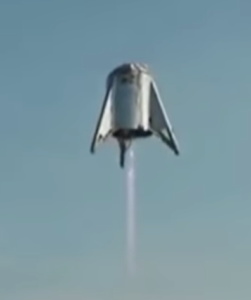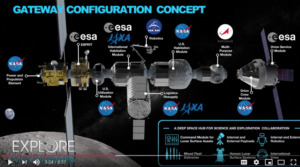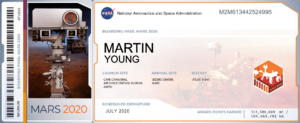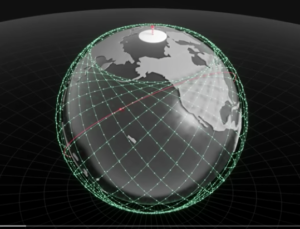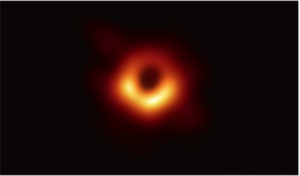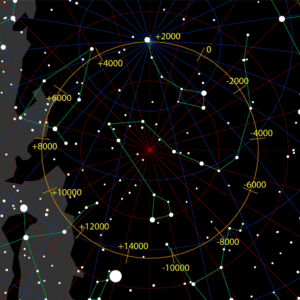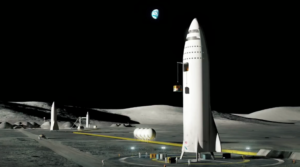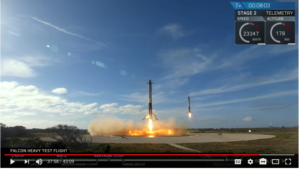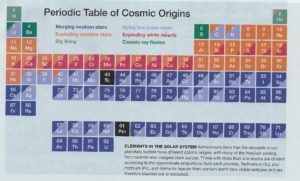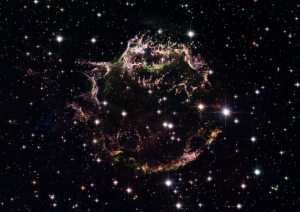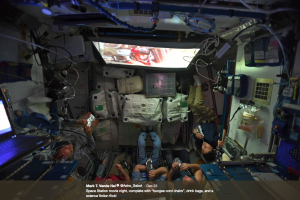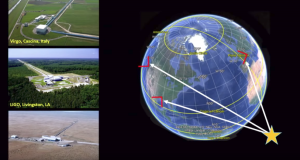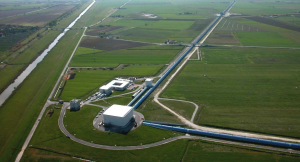the following Minutes are from notes and memory, apologies if these are not the meetings you remember. M.
General meeting Friday 9th October 2020, held at LE RANC
We were 8 in number, at the first general meeting held at LE RANC, Those present: Michael Cowell, Chris and Carole Fogg. Lydia Roziere, Meg Early, Bruno Valtier, and Monica and Martin Young. (I took the photo, M)
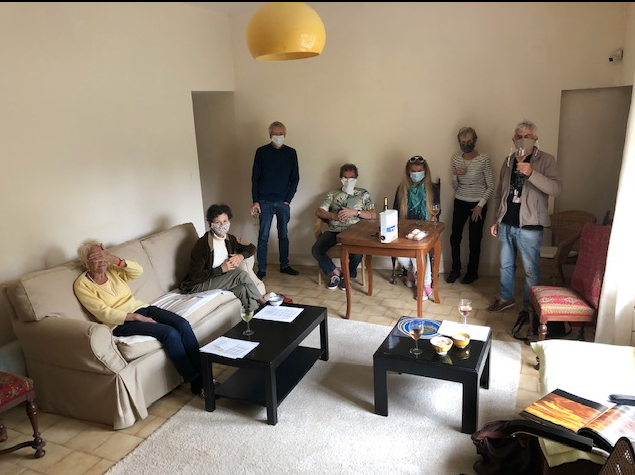
************************************************************************************************************************************************
Minutes of General meeting of 9th October 2020
On the subject of sunrise and sunset times on the ephemera notes: “Up here in the mountains we have no idea when the sun rises” That’s exactly why we note these times: Sunrise is defined as the moment the upper limb of the sun appears at the horizon for an observer at sea level. Sunset is when the upper limb of the sun disappears below the horizon. Our area of interest 45ºN and 4ºE is a good 20 minutes wide. The times given are therefore approximate.
We had a short discussion on our new meeting venue: The words: “great” “comfortable” “more roomy than Teapotes” and ”just right” come to mind.
Michael Cowell, (Interplanetary Soc.) gave us a splendid presentation on the planet VENUS. this was followed by a video presentation of many brief shots of the surface, complete with volcanoes and sulphuric acid rain.
Michael’s List of Missions to Venus from Mariner flyby to Parker Solar Probe is listed under Historic (HOME)
He followed with further YouTube videos of SpaceX and the forthcoming “Space hop” ,including details of the “raptor” engines, Atmosphere and Vacuum specific.
We completed the morning with a glass of wine(see pic) Thank-you Chris and Carole for your hospitality
************************************************************************************************************************************************
General Meeting Friday 11th September 2020, held chez Young at Ribaute
We were 9 in number, and we were outside on the terrace. (the weather was perfect, and parasols were deployed) Those present: Michael Cowell, Chris & Carole Fogg, Judith McHugo,Lydia Roziere, Meg Early, Bruno Valtier, Monica & Martin Young
We opened with a discussion on the Covid situation and how it would affect the near future (winter) meetings. To abide with social distancing (seems like forevermore) we would accept the kind offer of Chris & Carole Fogg, for use of a spacey internal salon at their chateau at Le RANC. St Sebastien d’Aigrefeuille.
Michael Cowell (our interplanetary representative) began with an outline of space missions to the ISS including Dragon (SpaceX) planned for 23 October. Not to forget three Mars probes all arriving at Mars February 2021. Some of us will be represented on Mars by our names (among 2.4 million others printed on microchips) carried on the Perseverance Rover landing at Jezero Crater 18 February 2021. Michael screened, among other items from YouTube, Sunita Williams’ Space Station Tour. (Look it up, this begins to show what it’s like, to be an astronaut working on the ISS)
I think we should purchase a suitable screen of our own – note this was discussed last December, before the Covid shut down.
Next Meeting will be held on Friday October 9th at Le Ranc at 10.30 am.
****************************************************************
General Meeting Friday 10th July, held at Ribaute.
We were 10 in number this morning, we held the meeting on the terrace (out of the morning sun) and in contact with internet. Thanks to Michael Cowell’s magic with YouTube we “explored Mars” with remarkable shots from Curiosity rover.
It was an interesting morning. My apologies for disappearing from time to time. This was due to “jobbing gardeners” turning up just at the wrong moment. We decided to skip the August meeting since most people would be on holiday and we set the second Friday in September (11th) for our next meeting.
In the meantime – Good Stargazing and follow “fridge notes”
Those present: Michael Cowell; Carole and Chris Fogg; Mike Clark; Meg Early; Jane Anderson; Lydia Roziere; Richard Hocknell; and Monica and me.
**************************************************************
THE END OF LOCKDOWN
“Just like wild animals held in a cage, they are reluctant to emerge when at last the cage is opened…… “
EXTRAORDINARY GENERAL MEETING held at RIBAUTE on Sunday 21st June 2020
We were Martin,Monica,Carole, Mike and Jane, Judith, Meg, and Lydia. eight members, Apologies from a further six. Why Sunday? Everything was shut so parking was easy, as it turned out, it was a perfect day. Read on:
We were complying with “social distancing” rules. We held our meeting outside (under sunshade etc) and we had plenty of room for 10 and easy parking.
We discussed the corona virus and were clearly divided by the optimist faction (It’ll be over by the end of the year) and by realism (this is now the new normal and we’d better get used to it.) We would like the Astro Group to carry on under that name (note: we are “Astro club” for French reasons ) And we should get back to meetings as before – ie on the second Friday of the month.
We discussed the “Ring of fire” today’s annular eclipse and used a globe to demonstrate the speed of the moon’s shadow across the earth even with the earth’s spin in the same direction as the shadow’s movement.
We spoke about developments in rocket science: Elon Musks’s Dragon and his Falcon series came under scathing attack “What’s it all for, we could save millions from starvation ” etc. My opinion is that nations cannot be saved from themselves, with corruption and mindless stupidity leading to mass emigration. I believe that landing on the Moon / Mars is essential for the sake of the human race. I do have some supporters I’m happy to say.
Next meeting will be held at same venue on Friday 10th July at 10.30 am
Members will be contacted by email
************************************************************************
Friday 13th March 2020 – Possibly the last meeting for a while, Bon Courage.
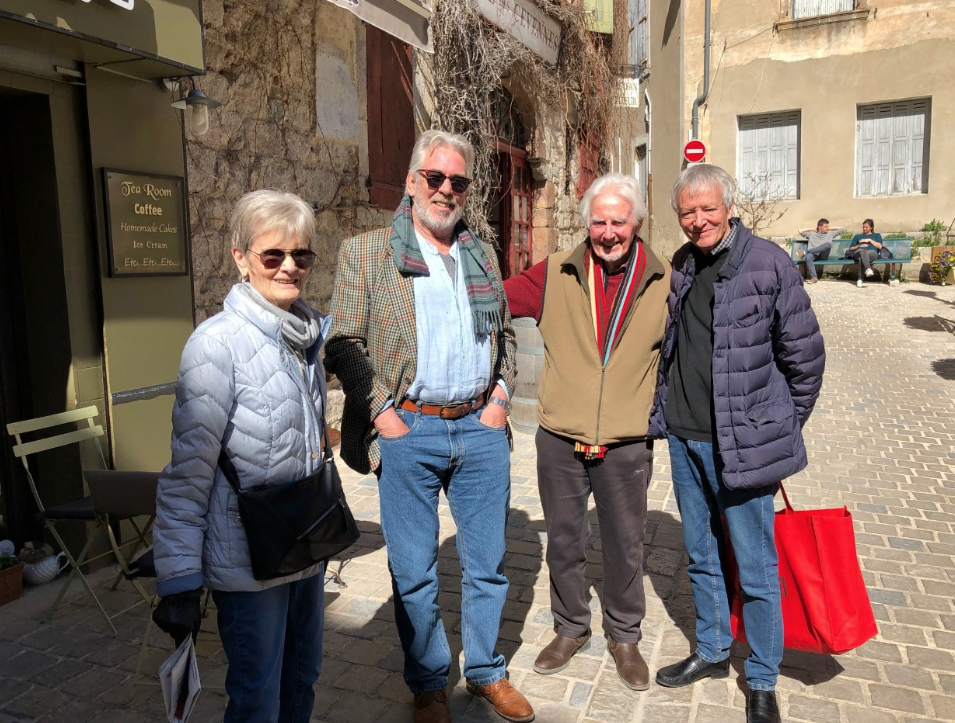
Friday 13th March **************************************************
We were down to eight attendees at today’s Astro Group Meeting, due to the impending Corona Virus Shut down. After distributing our “fridge notes” we watched the following on a 30 cm video screen: currently lent by Michael Cowell.
***********************************************************************
I think we started with the Elon Musk (spaceX) recent explosion while running pressure tests on the static SN 1 (Scott Manley narration) Curiosity on Mars including sky crane simulation. and great vistas of Mars. next was Cassini to saturn launched Oct 1997 (I had forgotten the gravity assist from Venus in June 1999 and then Earth and Jupiter) before arrival at Saturn (orbital insertion July 1st 2004) and mission of 13 years and 76 days in orbit at Saturn. well worth watching. and finally Asteroid mining: Japanese landing of cube sats on Ryugu Mission Hayabusa 2 and return of sample to Earth.
This is the best way to run our Astro Group Topics – It is vastly more entertaining and stays in the memory. Sorry you missed it, Bob and Terry Crayne, Bob Payne, David Miles and Carole and Chris Fogg.
Bon courage mes amis. Martin
**********************************************************************
St Valentine’s Day: 14th of February meeting. A sunny Spring morning at last, we were only 9 in number, colds and flu had taken their toll. And to those under the weather, we wish you a speedy recovery.
We have at last caught up with current media trends: Michael Cowell brought in a ~ 30 inch TV screen and connected to his i-pad could show images (and sound) from the internet. YouTube, in particular is a good source of Astro subjects/ topics.
So we had an interesting and entertaining meeting with Elon Musk and Falcon9, the test firing of the escape module for the Dragon series using re-useable first stage rockets. We visited various Messier objects, We studied M51, the Whirlpool Galaxy; several star clusters, and the Great Andromeda Galaxy which is rushing towards us at around an earth radius a second and will be merging with the MilkyWay in five billion years or so.
Thanks Michael, a great improvement for the Group. M
*********************************************************************
Friday 10th January 2020: we were 7 in number on a rather wet and foggy Winter morning. Our main topic was a tutorial on the night sky and the recognition of the Northern constellations, starting with the asterisms of the ecliptic (the Zodiac) The Ram, the Bull, the Heavenly Twins, and next the Crab the Lion shines, the Virgin and the Scales, the Scorpion, Archer and Sea Goat, the Man who pours the Water out, and Fish with glittering tails.
************************************************************************
Friday 13th December: See photo below

Minutes for December meeting to be completed:
************************************************************************
We were eleven in number at our November meeting,
We started with the November-December ephemera, I had omitted the ISS data and read it out for those interested – only five occasions where the magnitude of the Station was better than -3.0 (shorter daylight hours)bc.
************************************************************************
Friday October 11th:
We were 13 in number at our October meeting:
Michael Cowell gave an excellent talk on the history of man’s fascination with Mars from Schiaperelli to the present space missions and landings.
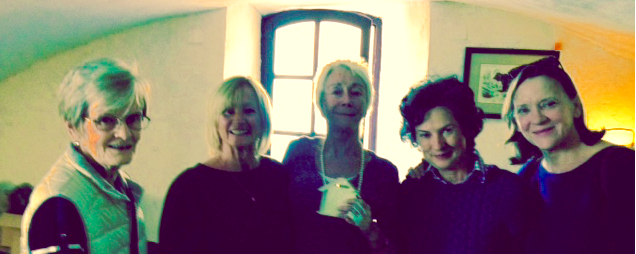
Friday September 13th: We were 9 in number on a warm September morning:
Our stated topics were Voyagers 1 and 2, Lunar landings after Apollo, (Michael Cowell) NASA news, SpaceX developments including “Starhopper”
Michael C. gave an excellent account of the technical and political snags and opportunities of the Apollo 12 to 17 Moon landings (Apollo 13 didn’t land)
“Just testing” SpaceX Raptor engine.
Friday July 12th: We were 14 in number on a hot July morning.
My apologies for a rather scrappy copy of fridge notes: due to my loss of the internet over 5 days and the weekend. – M
Marking the 50th Anniversary of man’s Moon Landing (Apollo 11) we welcomed Michael Cowell (British interplanetary Society) who gave a superb talk on NASA’s manned Spaceflight program – from the early Mercury through to the Apollo missions. Thanks again Michael, much appreciated.
With the echo of the brilliant Apollo talk I reintroduced the Gateway concept: this is a “Multiple Translunar Injection” with a “free” return trajectory of a minimum of 8 days.
this is the Gateway configuration involving a “caravan” of production tested components including Moon landers in translunar orbit.
Cosmological discussion was postponed to future meetings…
Martin
Friday June 14th: we were 10 in number on a wet and thundery morning at Teapots.
Our intended topics were 1. ephemeris (fridge notes on planetary motion) and 2. SpaceX STARLINK: (Elon Musk) launches 60 satellites at once. These satellites are the first batch of a total exceeding 7000 in orbit (see illustration below) each 300kg unit is independently powered and will attain a spectacular grid of orbiting emitters over a range of (FCC approved) 3-300 GHz transmissions. The mind boggles. 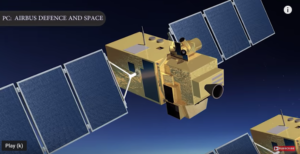
click on pic
Starlink satellite sketch
3. Mars 2020 Rover (plus helicopter drone) The “Ticket to ride” is delightful NASA publicity where your name is embedded on a chip (microscopic) and will be carried on the new Rover which departs July 2020 from Cape Canaveral arriving at Jezero Crater (Mars) early 2021. Note there are already some 2 million names. The list is to be closed September. You also get “air miles”
I have my ticket to ride:
Mars 2020 lander.
14th June Minutes to be completed:
Ephemeris (outlined inclination of ecliptic of East and West horizons)
SpaceX starlink. 60 satellites at once
Copied from Wiki
click on pic
Friday May 10th :
We were 16 in number at TeaPotes on Friday 10th May, Our meeting room was packed, we were nearly running out of room. Was it our new speaker, or coincidence…
Ephemeris: we asked the meeting for feedback on our “fridge notes” and should we retain the ISS data ? The answer was yes, continue as it is. Leave an interval for QUESTIONS during talks.
We started topics with the International Space station (launched in 1998) to the present The first few years it was orbiting at 340 to 400 km. see graph below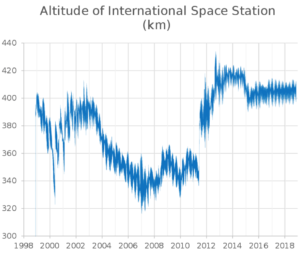
click on diag to enlarge
A little history is appropriate now, the space shuttles (originally orbiters) were in use long before the ISS was commissioned 1998. See Astro Notes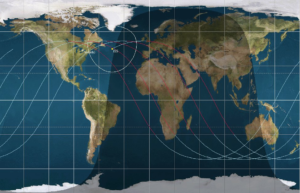
The above map shows ISS orbital tracks and day/night example. Note max latitude is 59º S and N
Topics also included black hole comparison table (I made a few faux pas on this subject last month) perhaps no-one noticed. We compare M87 to our own galactic black hole in Sagittarius. ie Sagittarius A*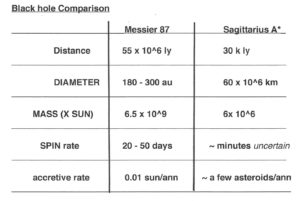
Finally we spoke about errant asteroids: APOPHIS (340m diam.) will pass Earth at 31,000 km on April 13 2029. that’s well inside orbit of moon and below all synchronous satellite orbits.
We spoke about DART – double asteroid redirection test which will take place in September 2022.
DAVID MILES (our “own archaeologist” ) gave an extremely interesting talk about the MEGAFLOOD and DOGGERLAND after the Ice Age, when the world’s seas were about 60metres lower than the present.
Thanks DAVID we appreciate that.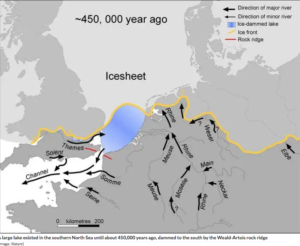
The meeting ended about 12.15.
Friday April 12th We were 14 In number, my copy of “intended order of topics” was as follows:
Ephemeris (discussion over times – the fridge notes say UT throughout, yet we use French time in the notes) We will alter the layout so the UT figures are clearer, the general comments on the notes will always be local time e.g. the viewing of ISS passes are limited to the area around Anduze. and are given in local time.
Bennu: throwing stones- Asteroid Bennu is really a mass of loose “stones” and is spinning up – at the moment 4.5 revs per hour. Ben. diam is ~ 500metres and this means that its equatorial gravity cannot hold stones in place. I enjoy imagining the sight of boulders not quite attached to the “ground” but rotating with the asteroid. No wonder OSIRIS REX was having problems locating a sample.
Israeli Beresheet probe lands / crashes on the moon. we spoke about the probe which arrived in lunar orbit last week, but lost track of its thrust direction (as far as we know) and ended up hitting the surface at high velocity.
first ever photograph of a black hole (or very long base line interferometry) v.l.b.i.
The best thing I can do is refer to YouTube: “zooming into the heart of messier 87”
March 8th: Well, we had a deserted cafe for our meeting (the staff were on vacation.) So TEAPOTES was specially opened for us (as we had already booked the meeting) nevertheless Olivier from TiffTaff (the pub on the corner) brought us coffees We were 11 in number.
Details of our topics tbc.
February 8th: We had a full house of 15 persons (including me) last Friday (8th) We belatedly distributed some twelve copies of S&T’s 2019 Almanac (50`N ). (It was intended that this should be done at our December meeting, but various delays intervened) NB We still have a few copies left if you’d like one. ephemeris for next month circulated.
We spoke briefly of New Horizon’s photographs of Ultima Thule from the Kuiper belt around 40 AU distant. Bearing in mind N.H’s passing velocity of 14 km / sec, and that the images are transmitted back (6.66 hours) and will continue being transmitted home over the next two months, until the memory is cleared. The quality of the photography is beyond expectation. pic of Ultima Thule circulated.
Other topics were Osiris Rex’s arrival at Bennu in the Asteroid belt on Jan 1st. Shortly it will be taking a regolithic sample and bringing it back by 2023/ see Youtube.com/watch?v=NYGHbl_esgw and further Youtube “Asteroid Bennu” clips. pic of Bennu circulated
Cosmology: I referred to Bob Crayne’s essay into the Multiverse. We (mankind) can see as far as the limiting horizon of c the speed of light. our visible universe is in theory around 26 billion light years across.(EAST to WEST) best reference:
The Cosmic Landscape, by Leonard Susskind, PB ISBN 978-0-316-01333-8
Back to our pocket sized universe; If you compare the size of a proton with the size of a star, you glimpse the size of the Planck constant. This is 10^19 (10 raised to power 19) this number governs the emergence of structure in the universe. The solar mass is about 2X 10 ^30 kg and that of a proton is 1.6 X 10^ -27 so a typical star like the Sun contains about 10^57 protons. Compare this number with the cube of the Planck number. 10^19 X 10^19 X 10^19 = 10 ^57. Interesting isn’t it. this is the smallest cube of space we can define / conceive. Einstein said “nothing can travel faster than light” and space is nothing, and appears to be expanding. For further reading:. (see A Zee’s book “ON GRAVITY” ) (see ASTRO READING)
Good Stargazing,
Martin
December 14th
Eleven stalwarts turned up at Tea Potes on 14th December, for our discussion and merry Xmas dinner at “l’o à la bouche” I think Mike C may have a few pics thereof.
November Meeting:
Heavy rain reduced our numbers attending our 9th November meeting, and with the closure of the Anduze submersible bridge, we were happy to see ten stalwarts at Tea Potes. Bob Crayne‘s instalment of the “Multiverse” was cancelled by inundation .
brief notes of topics:
Stellar and planetary Ephemeris (including ISS passes) circulated.
InSight (Mars probe) enters Mars tenuous atmosphere on 26th Nov at 16:45 UT, how’s that for accuracy. Landing estimated 19:53 UT. (see NASA.gov)
Dawn mission is ended; Dawn (ion drive) has finally used up all fuel and will now orbit Ceres forever. All Dawn’s transmissions are off.
New Horizons (inner Oort cloud) passes Ultima Thule 1st January 2019. and will then head out into the Galaxy forever. Yes, probably longer than Earth, makes you think.
The Parker Solar Probe reached perihelion 5th Nov within 15million miles of Solar surface top speed of 213,200 Mph.
We said quite a few words on gravity. we started with Galileo who knew that all masses fall with equal acceleration. and we drew the tower of Pisa and weights etc
We discussed earth’s surface gravity g, 981 cm/sec/sec jolly close to 10m/s/s and using Newton’s first law F=mg we determined the velocity of a particle (or a man) free falling after n secs , n=1,2,4,8 etc and showed that the value of g still increases after passing thru earth’s surface (see diag from Wiki) and of course falls to zero at the centre. And I hope we cleared up some confusion with pressure and gravity. Yes there is enormous pressure at the centre of the Earth.
We mentioned Einstein’s “man in a lift with a weighing machine” demonstration (he couldn’t tell if he was on the surface or in a rocket) We mentioned how small the value of G (big G) was in deep space – G = 6.7 X 10 to the power -11 Newtons. and how the inverse square law ever so slowly allows G to rule the universe.
Just look at the diagram carefully – g increases until about 3K radii (a point to remember)
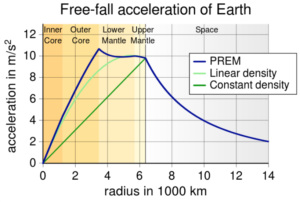 We pictured gravity on Mars and the Moon, 0.38% and 0.17% respectively and discussed a future Mars colony with a swimming pool. Would we float higher ? That would cost a lot. Imagination is a wonderful thing. I think it all went swimmingly!
We pictured gravity on Mars and the Moon, 0.38% and 0.17% respectively and discussed a future Mars colony with a swimming pool. Would we float higher ? That would cost a lot. Imagination is a wonderful thing. I think it all went swimmingly!
Next meeting is December 14th (see Carole Fogg for merry Xmas Dinner details)
Good stargazing
Martin
October Meeting:
We were 17 in number at our 12th October meeting! a bit tight for TeaPotes. our thanks to MARTINE who opened up TeaPotes and stood in for Sandrine who is on holiday.
IF THERE’S TIME…. proceedings
EPHEMERA The distribution of the next four weeks astro-ephemeris raised a short discussion on the subject of “summer time” the surprising result was that a majority were against changing the hour at all. Just leave it alone, I wasn’t clear if it should be left an hour forward of sun time or not.
Hubble and Reaction Wheels : There is a very good summary on YouTube of the nature of the problems with the 3D attitude controls used on space probes. Just enter “reaction wheels” in the YouTube search box. and click on “Why so many spacecraft are failing” Scott Manley explains new research. Unexpected result. “use ceramic bearings” I thoroughly recommend watching if you are on the internet.
InSight Mars Lander. Will arrive at Mars on November 26th. together with two cubesats (Marco 1 and2) the cubesats will record the landing !!! Results are relayed back to Earth by Mars orbiters. It feels like we’re living in the future.
The Mars rover Curiosity was built with two computers, one a spare. Curiosity is to “switch brains” was NASA headlines this week. Curiosity landed on Mars August 6th 2012. and has been using the second of two internal computers since then. The “spare” had already been used during the voyage to Mars and had been “swapped” when a problem in memory acquisition turned up. Since then the engineers “Tigers” had sorted out the problem with computer 1 and now it is to be used again. You just can’t leave anything to chance !!
Japanese lander Hayabusa at the 1 km dia. asteroid Ryugu, details of sampling the surface material and more cube sats, see (www. NASA.gov) The Japanese have been allocated time slots on space communications network.
Bob Crayne gave another interesting and controversial talk on the Multiverse (part three). He promises further talks on the subject…
Having often been asked the email address of the ISS data: herewith again: Just go to www.heavens-above.com and follow the menu from there. There is a map on the site to plot your geo position.
And also the rhyme to remember the order of the Zodiac ( ecliptic constellations ) is as follows: “the Ram, the Bull, the Heavenly twins and next the Crab the Lion shines, the Virgin and the Scales, the Scorpion, Archer and Sea goat, the man who pours the water out, and Fish with glittering tails.”
Good Stargazing, Martin
September Meeting: We were twelve in number at our September meeting.
We opened with distribution of Ephemeris covering the next thirty days, including the ISS pass times and positions. (see www.Heavens-above.com) and observer’s Handbook.
we spoke about the two Mars rovers : Opportunity which has probably run out of power due to the current dust storm covering its solar panels with a layer of dust. And Curiosity (now in region of Mount Sharp) Curiosity is powered by NASA’s MMRTG which is Multi-Mission Radioisotope Thermal Generator. (Ceramic form of Pu 238 which has half life ~87 years). Estimated useful life of Curiosity {Emily Lakdawalla book} is another 12 years – 2030. we spoke in our July meeting of its arrival by “sky crane” August 6th 2012 and that makes about 1800 Sols so far.
We spoke about the Parker Solar Probe, and I attempted to explain why we need more rocket power (~ speed) to send probes towards the Sun than to Kuiper belt.
Osiris Rex and Bennu (asteroid which is lounging at Lagrange point L4 ) was discussed at length. Bennu is a likely earth threatening asteroid (500 metres dia) and we need to know more about it – is it a loose collection of rocks etc. OSIRIS REX arrives at Bennu ~ 3rd Dec 2018.
Mars Lander INSIGHT arrives Mars this November: The main point of this lander is to drill into the regolith to analyse the rock and to determine heat transmission from the planet.
New Horizons after passing Pluto in 2016 it is now nearing another Kuiper Belt Object, namely Ultima Thule which is 50 AU’s distant and should pass it (at speed) on New Year’s day 2019. (this was picture on Tea Potes Poster)
I think I embarked on several tangents during my presentations as usual, however the above is my best recall. Martin
Questions please:
BOB CRAYNE continued his discussion on the MULTIVERSE, with part two.
July Meeting: We were fifteen in number at our July meeting, and it was hot.
Bob C embarked on the Multiverse Theme with Part 1, ( to be continued)
David Miles gave another interesting short talk on a new (to me and probably to most of us) aspect of archaeology, some ancient artefacts from c1400BC: namely the Trundholm Sun Chariot and The Nebra Sky Disk. and left us with the question ; How sophisticated was Bronze Age cosmology in a pre-literate society ?
I think these talks widen our earthly horizons, we now take a break until September 14th.
keep in touch.
Good stargazing, Martin
June Meeting:
CURIOSITY: How the Mars Rover Performs its Job, by Emily Lakdawalla
I’ve been reading a new book on the Mars rover Curiosity. This book describes the most complex machine ever sent to another planet: Curiosity is a one ton robot with two brains, seventeen cameras, six wheels, nuclear power and a laser beam on its head. No one human understands how all of its systems and instruments work.
This was our main topic at June 8th meeting. (we were thirteen in number at Teapots ) I hope I managed to convey those “ Seven Minutes of Terror” from the point when the space craft enters Mars’ atmosphere through the deceleration phase, the ablation shield, the lifting body phase, navigation of a “flying saucer” deploying the parachute and finally the sky crane phase. culminating in depositing Curiosity on its wheels almost spot on target at Gale Crater. Not forgetting the photograph taken from the Mars Reconnaissance Orbiter of the landing -showing the parachute from above. If you’re interested, just look at youtube “Seven Minutes of Terror” clip.
Good stargazing,
May Meeting: We were ten in number at our May 11th Astro Meeting. Our topics have become more varied over the past year and seem to be moving towards Natural Philosophy than “mere” astronomy. We mooted a change of name for our group. A definitive No, so we’ll stick with “Astro Group”.
Notably, David Miles gave us an interesting talk on chronology, including radiometric (carbon 14) and molecular dating. the talk was well received. (applause) Thanks David ,
Under the topic of the Moon’s complex orbit, I tried to model the moon’s orbit with a yellow hula hoop and a tennis ball with a pencil thru it (as earth axis). This demonstration needs considerable improvement. M
April Meeting: Despite the rain, we were 9 in number at our April 13 th Astro Meeting.
Many thanks to Sandrine for her “rock cakes”. Topics were the INSIGHT Mars lander, the Parker Solar Probe, and TESS due to launch APRIL 16TH, TESS is NASA’s Transiting Exoplanet Survey Satellite. This is a replacement for Kepler and consists of four cameras. Tess will spend about two years surveying 200,000 of the brightest stars near the sun to search for planets outside our solar system.
We were 12 in number at our March 9th meeting.
We chose the interview between ground control and Dr Andrea Hanson (pictured) exercising in the ISS as our main topic. These “Zero Gravity Workouts ” are the difference between life and death for the astronauts. Everyone on the ISS has to exercise to a high level for two and a half hours, six days a week. These exercise regimes have to fit into the busy schedule for all astronauts.
Dr Hanson running on Advanced Resistive Exercise Device (ARED) –
Dr Hanson (the International Space Station Exercise Countermeasures Operations Ops Lead) She has a big title for the big job at the Johnson Space Centre. A few exchanges between ground and Dr Hanson should illustrate the reason for this: ” Bad stuff can happen to the human body when astronauts are in space for a long time, and counter-measures are just a way to prevent that stuff from happening”
Andrea Hanson: So the body responds pretty immediately to living in the microgravity environment through going through a series of adaptations to adapt to this new sensation of free float. And those adaptations happen pretty immediately. Upon getting into outer space, you experience fluid shifts, and that might cause, like, a stuffy head sensation and maybe even some slight motion sickness in the first day or two. But the spine starts to elongate, and, immediately, all those little mechanosensors that tell your body it needs to keep strong to even stand up straight, go up and down stairs, sit in a chair, and stand up again, they start to turn off, and that’s where we start to see the muscle strength losses and bone atrophy that we know our astronauts can experience, even at as soon as two weeks in space.
Ground Control: What are you seeing with the astronauts whenever they come back? How, what’s the length of time until they’re, I guess, “back to normal”?
Andrea Hanson: Well, that’s a really good question, and I think that the answer varies for the different systems of the body that you want to talk about. But there, of course, most crew are able to get up and walk around on their own within a day or two after landing. And they are getting back to regular exercise programs, at least. Muscle strength, if there were losses that were experienced during their spaceflight mission, can be returned to baseline values within two to six months, depending on, again, the individual and how they adapted both to space and coming back to Earth. But when we look at those long-term turnover systems like our skeleton, those can take a little longer to recover. And of course, you have other factors playing into this that include age, normal activity levels, and, again, the stressors of this schedule that astronauts experience upon coming back and needing to fulfill a lot of those post-mission responsibilities. , I don’t think ARED would even fit. It is a very large device. It’s very heavy and very capable. I think everyone would love to see ARED being sent to Mars, or at least a derivative of it. And that’s really what we’re trying to do — taking all those lessons learned from that hardware design and the stresses that has been put on that hardware to make sure that the devices being designed for those smaller exploration vehicles are going to be able to stand up to the stresses and the continuous use that we expect that they will have. And so right now, while we’re being challenged to kind of design, have one piece of hardware that’s going to be a cross-training, both aerobic and strength-training device, we know that multimodal exercise is important, which is why we have the cycle, the treadmill, and the strength-training device today. But also, that robustness and the ability to make sure that we have operational hardware available is almost as important as the functionality of any one device.
Andrea Hanson: That is such an important question and really important to recognize today when the crew lands back on Earth, they have an entire welcome wagon here ready to help them up and out of the capsule, and get them to the medical support tents, and make sure that they are safely on their way home. When we land on the surface of Mars, that welcome wagon will not be available. So what we’re working on today is creating a real autonomous exercise system so that we can provide the crew with really individualized and meaningful fitness goals. And how do we do that? Well, we took a look and evaluated, what kinds of tasks are they going to have to do once they land on the surface of Mars? And some of those are pretty obvious. They’re going to have to get up and out of the capsule [laughs] and safely to that prepositioned habitat or equipment that will help them set up base. They’re going to have to walk around on this unfamiliar and probably uneven terrain and be careful not to experience unnecessary trips and falls along the way. And if they do, they might have to help an incapacitated crew member.'”
Enough said, We have to get this fitness training right before we embark on any attempt to go to Mars, (Mars is minimum of two months journey time away let alone the return time when Earth – Mars positions are right again). It looks like working on installing a Moon base is the better first step. M
Just looking at our March talk, We must mention The Vernal equinox on March 20th the Sun crosses the equator at 16.15 UT, so if precession comes up let’s be ready. This star chart shows the earth’s pole position thru history. Vega is bright star at bottom
The red circle is of radius 23.5 deg
and the millennia dates are shown
click on image for clarity.
Elon Musk’s MOONBASE, a good topic for our February 9th meeting.
Yes, Friday’s meeting saw nine of us at TeaPotes. Elon Musk’s ambitious targets were discussed, We spoke about the youtube vid of Elon Musk’s test launch including the return of two of the booster “Falcon 9” rockets. That was Contemplative Art. That’s the only way to describe it. We mentioned the ‘Waffle Iron” steering fins on the Falcon 9s and the nine gimballed Merlin engines allowing the ballet of the reusable boosters to perform faultlessly. (The Falcon booster to the 2nd stage and payload went out of touch and didn’t survive a splash down in the ocean.) Apart from that, it was amazing. below is a still from the youTube vid. showing the Falcon 9’s returning to their pads at Canaveral with their landing legs deployed.
click to enlarge
We note the payload, (Tesla all electric car complete with space-suited mannequin) is now installed in solar orbit. I understand this orbit reaches the near asteroid belt and back to Earth orbit. Proving that Mars is a practical target for future spaceX missions.
Bob Crayne, newly returned from snowy New England, gave a talk on the heavy topic of dark mass and dark energy. E=mc^2 again.
good stargazing,
Martin
Notes on Cosmic Origins of elements, This is latest (2018) Periodic table of the creation of elements.
click on image for clarity, the script for this tbd
CASSIOPEIA ‘A’
as seen by Hubble, compare with Chandra’s view below.
JANUARY 12th TOPIC:
“There is plenty of information there, if only we could see it….”
Cassiopeia A (Cas A) is a supernova remnant (SNR) in the constellation Cassiopeia and the brightest extrasolar radio source in the sky at frequencies above 1 GHz. The supernova occurred approximately 11,000 light-years (3.4 kpc) away within the Milky Way. The expanding cloud of material left over from the supernova now appears approximately 10 light-years (3 pc) across from Earth’s perspective. In wavelengths of visible light, it has been seen with amateur telescopes down to 234mm (9.25 in) with filters.
It is estimated that light from the stellar explosion first reached Earth approximately 300 years ago, but there are no historical records of any sightings of the supernova that created the remnant. Since Cas A is circumpolar for mid-Northern latitudes, this is probably due to interstellar dust absorbing optical wavelength radiation before it reached Earth. (Wikipedia)
CAS A as seen by NASA’s
CHANDRA (X-ray probe)
This is a vast cloud of stellar debris, rich in the heavier atoms of the periodic table.
I Love this photo from the ISS:
click to enlarge
Notes on November’s lecture;
“Multiple messengers”
Representation of the three LIGO stations that detected GW170817, click to enlarge
Picture of VIRGO site near Pisa, Italy:
NASA announcement:
For the first time, NASA scientists have detected light tied to a gravitational-wave event, thanks to two merging neutron stars in the galaxy NGC 4993, located about 130 million light-years from Earth in the constellation Hydra.
Shortly after 5:41 a.m. PDT (8:41 a.m. EDT) on Aug. 17, NASA’s Fermi Gamma-ray Space Telescope picked up a pulse of high-energy light from a powerful explosion, which was immediately reported to astronomers around the globe as a short gamma-ray burst. The scientists at the National Science Foundation’s Laser Interferometer Gravitational-wave Observatory (LIGO) detected gravitational waves dubbed GW170817 from a pair of smashing stars tied to the gamma-ray burst, encouraging astronomers to look for the aftermath of the explosion. Shortly thereafter, the burst was detected as part of a follow-up analysis by ESA’s (European Space Agency’s) INTEGRAL satellite.
NASA’s Swift, Hubble, Chandra and Spitzer missions, along with dozens of ground-based observatories, including the NASA-funded Pan-STARRS survey, later captured the fading glow of the blast’s expanding debris.
Some notes on Sun
September’s lecture
the Sun’s remarkable output.
In the 19th century lord Kelvin calculated the Sun’s energy output- if it were coal fired it would only last 20,000 years. There has to be some other process at work… It wasn’t until 85 years ago (late 1930’s) that the American physicist Hans Bethe worked out the details of the nuclear fusion reaction taking place in the interior.
The Sun is about 71% H2 and 27%He + 2% heavier elements. . The sun is 1.4 million km across (800,000 miles) or 100 Earths. (It could contain around 1.3 million Earths)
In the core of the Sun the H2 gas is strongly compacted by the weight of the overlying layers. The density there is 13 times the density of lead. Atomic nuclei start to fuse together – nuclear fusion.
NOW THE THOUGHT EXPERIMENT:
Suppose we could switch on the Sun for just one second –
In just one second 570 x 10^6 tons of Hydrogen take part in fusion reactions. (c.f. concrete cube with sides of 600metres) or some 3.4 x 10^38 hydrogen nuclei. These hydrogen nuclei (single protons) are fused into He nuclei. (The He nucleus is 4x mass of a proton. So for every 4 Hydrogen nuclei that go into the fusion reaction, one He nucleus comes out.) That’s still a lot, if you divide 3.4 x 10^38 by 4 you end up with 8.5 x 10^37.
So every second a large number of protons fuse into Helium atoms. This is the tricky part: The Helium nucleus is about 4 x mass of a proton – it’s a teeny-weeny bit shy of that, in fact in goes 570 million tons of H2 – out comes a mere 566 million tons of Helium (0.7% less) what has become of the remaining 4 million tons of mass ? You may have guessed – it has been converted into energy E = mc^2. Einstein all over again. So during our 1 second thought experiment, the Sun has lost 4 million tons of mass. In case you’re wondering how can there be any Sun left at all – just do the calculations:
If the loss of mass has been constant over the Sun’s lifetime of 4.6 billion years (145 quadrillion seconds) the sun is less massive by 6 x 10^23 tons than when it first ignited. (That’s only 0.03% of its total mass of 2x 10^27 tons nothing that spectacular) (for a person weighing 100 kgms ).03% = 30 gms,
So the upshot is the Sun converts 4 million tons of mass into pure energy each and every second. That’s a lot of energy: 400 quadrillion gigajoules or a million times the annual consumption of all humanity in one second.
What happens to all this energy ? It’s in the form of gamma rays, but these are pretty much locked up in the Sun’s interior as the 15 million degree core is pretty much opaque. Gamma ray photons can’t travel very far. As a result the energy that was released in our single second is being absorbed, reemitted and scattered in random directions within the Sun, only to be absorbed and emitted again and again. Hardly rapid progress.
In a perfect vacuum light travels at 300,000 kms/sec . You might expect that the radiation from the Sun’s interior to reach the Solar surface in just over 2 seconds, a mere 700,000 kms. But in reality it takes about 100,000 years due to the Sun’s opaqueness. So the 400 quadrillion gigajoules worth of energy produced during our 1 second won’t reach the surface until 100,000 years from now, and then it takes only 8 minutes to reach Earth through the near vacuum of interplanetary space. In a sense we’re now receiving energy that dates back to the tome of primitive Homo Sapiens. The same story also holds for all the stars in the night sky.
C Govert Schilling “Ripples in Spacetime” ISBN 9780674971660

